By Allie Rudd, GreenLight Collectibles
Visit most automotive shops and you may find a die-cast vehicle sitting on the shop owner’s desk or shelf, or displayed on top of a technician’s toolbox.
Maybe the collector car was a gift from a vendor or supplier. Or the owner likes to display the car as a tribute to his favorite race car driver. Or maybe collecting die-cast cars just so happens to be a hobby of the shop owner.
Whatever the reason, die-cast car collecting continues to grow in popularity as new models are introduced to new collector fans each year. 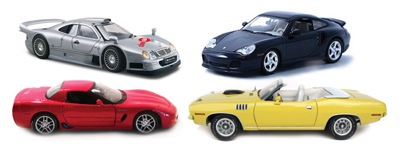
According to Indianapolis, IN-based GreenLight Collectibles, the hobby of collecting is an activity that has entertained the masses for decades and includes countless possibilities.
Kevin Davey has a passion for cars that he drives into his GreenLight company — a premier manufacturer and marketer of officially licensed die-cast replica vehicles. GreenLight-manufactured models vary from Indy cars to muscle cars, sports cars, trucks and police cars and all are incorporated into fun-to-collect product themes including Muscle Car Garage, Auction Block, County Roads, Hot Pursuit, Motor World and many more.
The die-cast models are offered in 1:18, 1:24, 1:43 and 1:64 scales and are sold to customers in three different segments — mass retail, hobby and specialty retail and the custom and premium market.
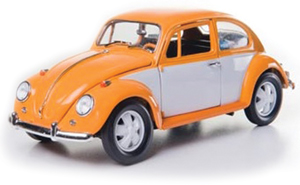
Founder and president Davey, an Indianapolis native, began his love of cars similar to many young children growing up in Indiana, through the Indianapolis 500. With a bachelor’s degree in finance and marketing from Marquette University, Davey accepted a job as the sales and licensing coordinator for the Speedway.
By 1993 he was the director of licensing, responsible for licensing the Indy 500 and Indy Racing League brands in multiple product categories, including die-cast replica vehicles.
Upon leaving IMS in 1998, Davey started a licensing and consulting business, representing various clients for license acquisition as well as brand extension licensing. Die-cast represented a large portion of sales, and in 2002, he decided to focus 100% of his businesses time on die-cast manufacturing.
This decision proved to be the foundation of Davey’s entrepreneurial career path and the beginning of GreenLight Collectibles.
Davey’s IndyCar roots were the influence for the first line offered by GreenLight, a 1:64 scale Indy Racing League driver’s collection. In these beginning two years, GL focused on racecars and pace cars until the first muscle car line was released in 2005 into its Muscle Car Garage line.
This line opened up broader distribution outlets for the company, creating more mainstream opportunities from a sales and distribution standpoint. The line included castings that had not been offered in the market or had not been executed well by other companies.
“We experienced great initial success with our first muscle car line and the opportunities to grow expanded from that moment on,” said Davey. From this offering, subsequent models in 1:24 and 1:18 scales were created and brought to the market.
In 2010, GreenLight, LLC, together with its affiliate, Under the Hood Club, LLC, announced a significant equity investment from a group of individual investors. Net proceeds from this investment are being used to accelerate the development of new projects and to expand more aggressively into licensed die-cast collectibles and related products that appeal to the company’s auto enthusiast customers.
“Our new investors recognize the tremendous following GreenLight has built among automobile die-cast enthusiasts,” said Davey. “They and we at GreenLight firmly believe our best days are ahead of us.”
Complete with a dedicated staff and unique product drive, Davey said GreenLight is set in gear to go beyond the checkered flag to the open road ahead.
“While the economy remains tough, we are gratified by the reception our products continue to receive from customers, both in the U.S. and internationally. And we have numerous new ideas and concepts we’re already working on that we’re confident will strike a chord with our core collectors,” Davey said.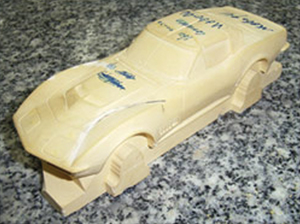
Attention to Details
Davey said GreenLight uses outstanding detail within its product lines and implements fresh marketing strategies. Its die-cast replicas are officially licensed by various property rights holders in the automotive and entertainment industries.
This official status allows the company to produce products that are 100% authentic, complete with rubber tires, authentic graphics, opening hoods, real engine detail and sequential numbering.
Davey said the GreenLight team is constantly brainstorming new ideas for the business, staying cognizant of market trends in the automotive industry as well as the hobby circuit. Attending auto auctions, trade shows and collector shows allows GreenLight to pick up detailed information as well as develop a variety of contacts for licensing and distribution.
“GreenLight has set a goal to create a brand that brings high quality, is entertaining to collect and is unique to the marketplace,” he said. “The ‘difference is in the details’ is a motto we use each day to drive the GreenLight brand into the hearts of collectors.”
R & D
According to Davey, there is a lot of thought and research that must go into selecting a vehicle to replicate. “A significant amount of research is done based on perceived marketplace viability and collectability, as well as researching which vehicles have not been produced by other manufacturers,” he said “We must think about cost effectiveness for the tool, like working variants into a run to maximize the use of each tool.”
Next comes licensing. Davey explained once they have decided which cars they would like to replicate, GreenLight must obtain permission from the car’s manufacturer. “A great benefit to being an official licensee is that we get to work directly with the car’s manufacturer (GM, Ford, Dodge, etc.),” he said. “This allows us to include the detailing and insignia that gives the GreenLight cars the authenticity and accuracy that the collectors crave.”
After that, the research process begins. Davey said countless hours are spent researching the make, model and detail of the car. His team uses reference photos, model kits and actual cars from public shows, private collections or car dealerships to research the details of each car.
Every little feature, including measurements, placement of logos, patterns, textures and color samples is researched. “Once the research is completed on our end, a ‘job bag’ that includes a comprehensive description of the car is sent to our factory located in the Guandong Province of China. With this information, the factory is able to construct a prototype of the car,” Davey said.
Length of Time to Develop Prototype
1:64 scale – 45 days
1:24 scale – 75 days
1:18 scale – 90 days
‘Building’ the Car
A prototype is originally sculpted in clay by hand, a very meticulous process that takes a lot of patience and focus. As seen in the image above of a 1:64 1978 Corvette clay prototype, the precision of the sculpting is impressive.
From the clay prototype, a resin prototype is produced. This resin sample allows the production team to view the car in great detail. The replica is reviewed extensively at this stage so that staff can catch any major changes that need to take place. The team sends the prototype to the licensor of the car for review and comments.
Changes at this stage are crucial and necessary. After this stage, the car mold will be cut in steel and any major flaws that are not detected can be very expensive to change and potentially set a project back for a couple of months.
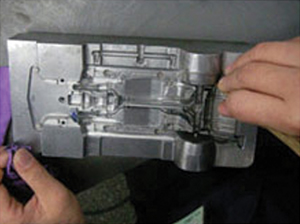 Upon approval of the resin prototype, the project is sent back to the factory in China where it is milled into steel blocks that create the mold. It’s important that the mold be filed and polished by hand to remove any imperfections before precise replicas can be produced. Here is a 1:24 scale steel mold of a chassis in its final stages of filing.
Upon approval of the resin prototype, the project is sent back to the factory in China where it is milled into steel blocks that create the mold. It’s important that the mold be filed and polished by hand to remove any imperfections before precise replicas can be produced. Here is a 1:24 scale steel mold of a chassis in its final stages of filing.
Molds for the interior and engine plastic parts are produced from steel molds as well. Once all the pieces of the mold have been polished and are ready for use, it’s time to produce the first die-cast replica.
Length of Time for Production of Steel Mold
1:64 scale – 60 days
1:24 scale – 90 days
1:18 scale – 120 days
First Shot
Before production of all the replicas can take place, the factory will produce two die-cast replicas from the mold called “first shots.” These first shots are fully assembled with all the interior and engine parts. 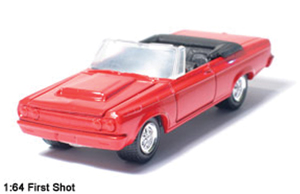
Each car is painted with a single layer of paint to better see the detailing of each car. Any areas of the car that will be chromed are included on the first shot as well. These first shots are sent to GreenLight for review, where one of the replicas is sent onto the licensor for review.
The changes at this point are usually minor.
Once the first shot is approved, the factory will produce a fully decorated version of the car. This includes the cars’ body paint, logos, painted interior and decorated engine. The sample is sent to GreenLight in Indianapolis for review.
Upon approval of these samples, production of the replicas can begin. The cars are made from the raw material, zinc alloy, which is melted and injected into the molds to form the casting.
Below is a shot of the zinc alloy material in its raw form.
After the cars come out of the mold, each car has to be filed by hand to remove the large pieces of excess raw material.
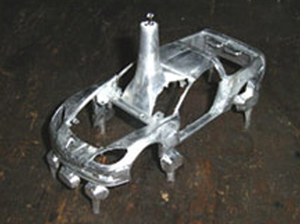 The die-cast bodies are then sent through a vibration trimming and polishing system where the cars are tumbled and washed to smooth rough edges and remove excess film. If the surface of the car is smooth, it is ready to be painted and brought to life.
The die-cast bodies are then sent through a vibration trimming and polishing system where the cars are tumbled and washed to smooth rough edges and remove excess film. If the surface of the car is smooth, it is ready to be painted and brought to life.
Each car is then spray-painted by hand with a white base coat, which serves as a primer on the die-cast metal. Each car body is then individually spray-painted. For each car part that requires a color other than the body color, the part is masked and painted. Car bumpers are often spray-masked.
After the paint has dried, the logos are affixed through a process called pad printing. A tedious stage in the manufacturing process, the logo machine and the car have to be synched and placed in the exact same position each time to assure proper placement of each logo. For each color in a logo or decal, the car must be “hit” with the pad-printing machine. So, if there are four colors in the logo, the car will be “hit” four times. Tires are also pad-printed one-by-one.
Once the paint has dried, it is time to fully assemble each car. The injection-molded parts for the interior of the car and engine are individually installed. When the car is fully assembled, each GreenLight die-cast replica is polished by hand and packaged.
The development of the packaging begins long before the car is ready to be packaged. Packaging is created much like the actual die-cast cars using clay prototypes. In the image below, the clamshell packaging GL uses for its 1:64 scale Muscle Car Garage is being created.
After the clay prototype has been approved, a bronze mold of the packaging is produced. Below, in the bronze mold, you can see the front and back of the clamshell packaging.
The packaged cars are then shipped. 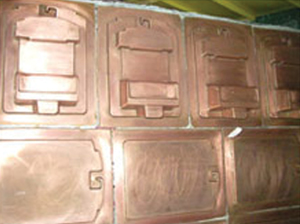
It takes about three weeks for the product to travel across the Pacific Ocean and reach a port city on the west coast of the U.S. where it is then distributed to a die-cast retail location and eventually into a collector’s hands.
“While the making of a die-cast collectable is an exciting yet tedious process with many ups and downs, seeing the finished product after an 8-12 month process is incredibly satisfying and rewarding,” Davey said.

